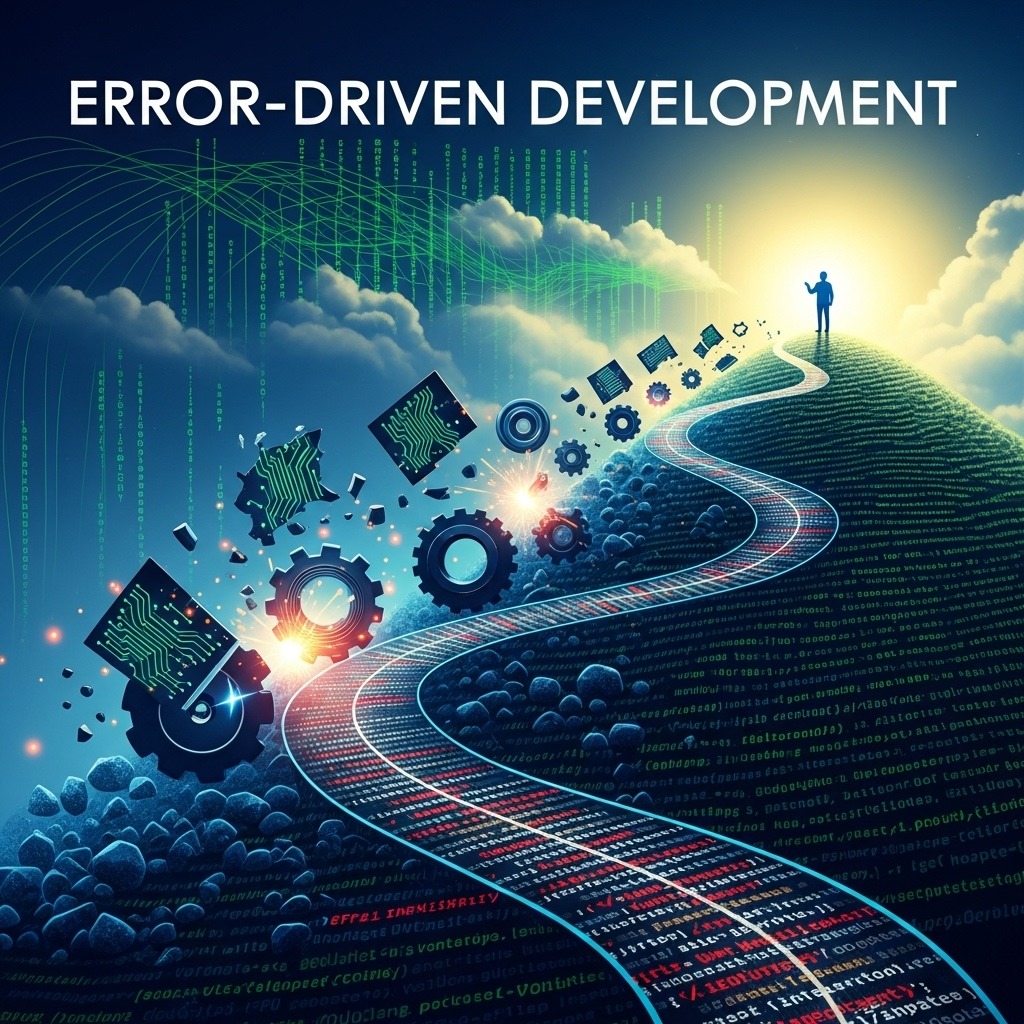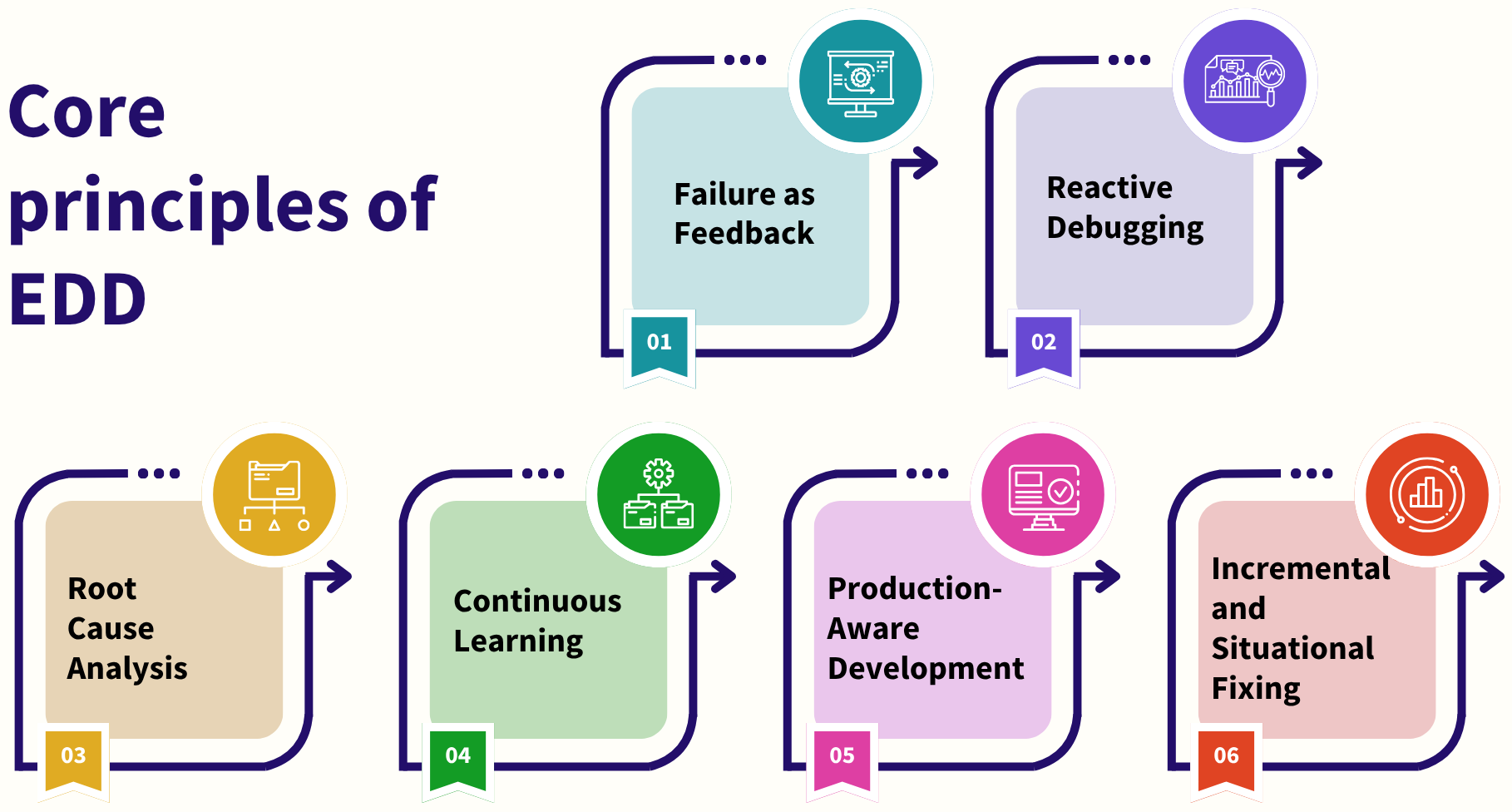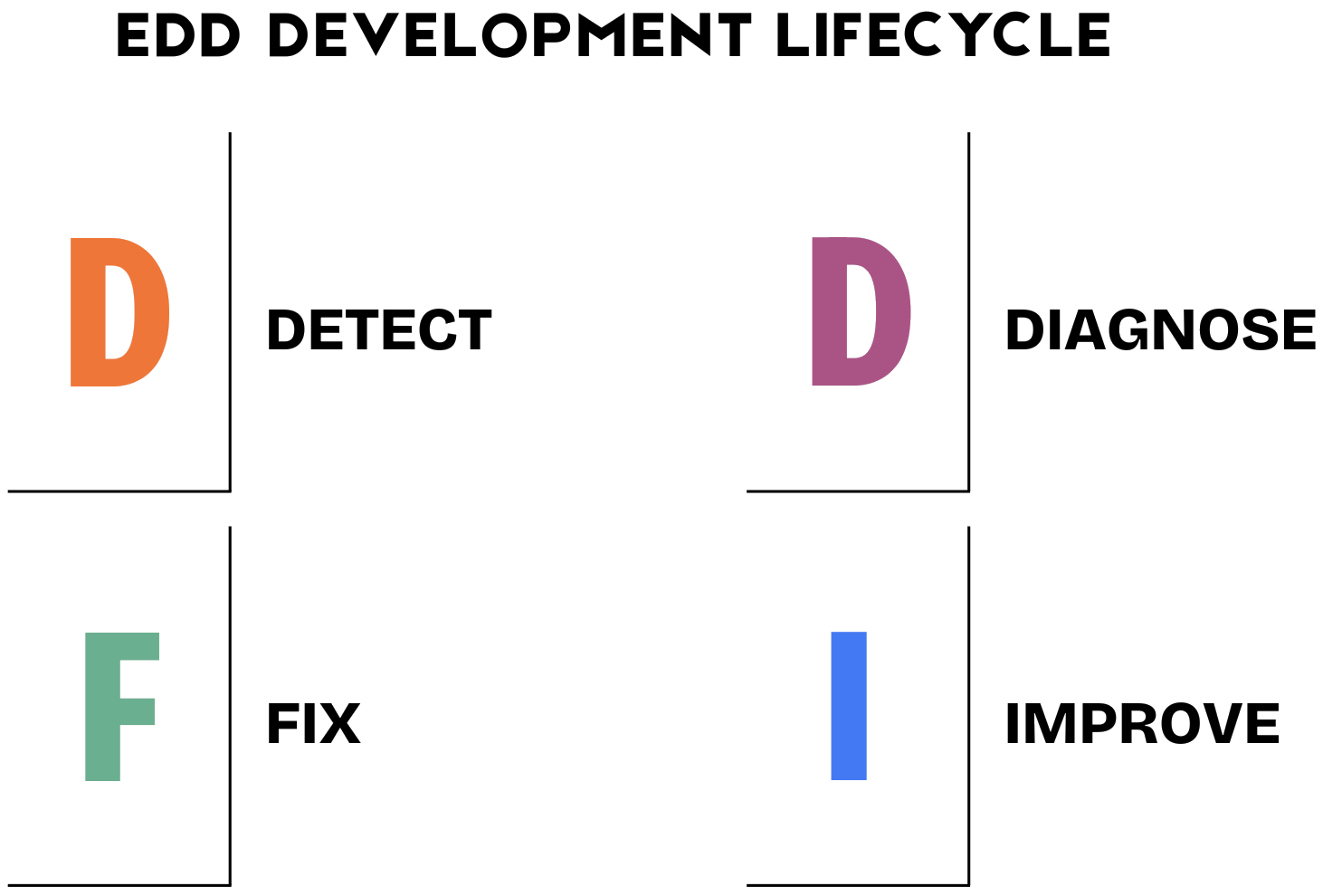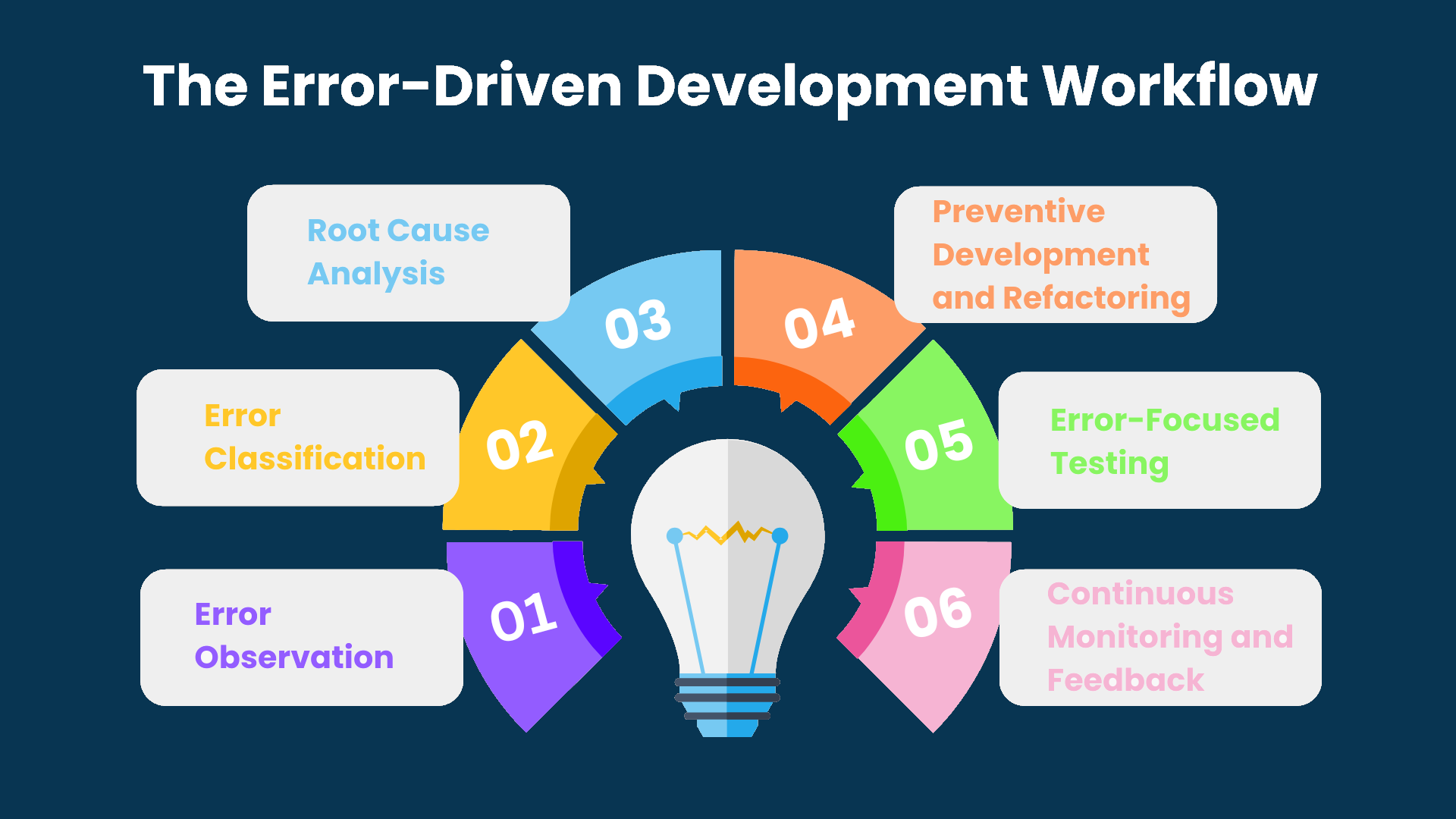What is Error-driven Development (EDD)?
|
|
Error-Driven Development (EDD) is a lesser-known but increasingly relevant software development paradigm that turns the traditional view of errors on its head. Instead of treating errors as post-facto bugs or exceptions to be avoided or fixed, EDD embraces them as first-class citizens in the design, development, and learning process of software engineering. It offers an introspective and empirical approach to development by focusing on what goes wrong, why it goes wrong, and how that feedback can be systematized to drive design, tests, learning, and evolution.
| Key Takeaways: |
|---|
|

Philosophy Behind Error-Driven Development (EDD)
Error-Driven Development (EDD) refers to a development methodology where live errors on software, e.g., ruptured software at runtime, production meltdowns, or other unexpected system behaviour, serve as the major source of feedback and input in development. In contrast to other, more traditional methodologies used to plan their features and tests, EDD is reactive in nature: it initiates with the identification of a problem and conceptualizes improvements around the repair of that problem.
The development cycle in EDD usually starts when an error is reported or when the systems fail a check, or when a user comes up with a complaint. Developers then troubleshoot the problem, understand the root cause of the problem and find a solution to it and also to enhance the surrounding system to prevent occurrences of the same. This is the reactive loop that makes EDD a very useful tool when used in an ecosystem where software needs to be dependable at all times, regardless of the circumstances.
Core principles of EDD
The main postulates of the Error-Driven Development are the following:

- Failure as Feedback: EDD does not view failures in a system as one-off misfortunes, but as feedback used to inform development and identify weak aspects of the system.
- Reactive Debugging: Rather than actively developing tests that precede when a bug would manifest, EDD is simply trying to have bugs identified and fixed at the time they occur.
- Root Cause Analysis: EDD stresses severe investigation of the source of mistakes, it does not opt to resolve the issue on the surface because it is very superficial and it only takes care of quick corrections.
- Continuous Learning: Every mistake produces a learning experience to deepen the developer knowledge, better design patterns or mature architectural choice.
- Production-Aware Development: EDD works best in a setting where there is effective use of monitoring, logging, and observability tools which help to make issues visible in the shortest time possible.
- Incremental and Situational Fixing: Unlike other programs that use generic changes, EDD uses conditions that embrace systematic, but also situational fixes towards specific questions.
EDD Development LifeCycle

The EDD process cycle usually has the following four phases:
- Detect: The errors are detected through monitoring logs, exception detections (e.g., Sentry, New Relic), user comments, or even automatic notifications. Error simulation of monitoring systems is important in error detection in real-time.
- Diagnose: Developers examine the error to identify the root of the cause. What may be done is examining logs, reproducing the bug, or looking at code paths.
- Fix: A personal code correction or setting is applied to the bug. Regression can be prevented by the addition of unit or integration tests after the fact.
- Improve: In addition to solving the current problem, the developers also make sure how possible errors can be avoided in future. This may include some form of validation enhancement, implementation of monitoring, brittle code refactoring, or documentation. Such a cycle helps to establish that any error one comes across will help in creating practical action, thus making the system a much stronger and sustainable one in the long-run.
| Aspect | Error-Driven Development (EDD) | Test-Driven Development (TDD) | Behaviour-Driven Development (BDD) |
|---|---|---|---|
| Timing of Feedback | After the error occurs | Before implementation | Before implementation |
| Feedback Source | Real-world errors, logs, and user complaints | Unit tests written pre-code | Specifications and examples |
| Focus | Fixing actual failures and improving stability | Preventing bugs through rigorous testing | Ensuring behaviour aligns with requirements |
| Typical Workflow | Detect → Diagnose → Fix → Improve | Test → Code → Refactor | Describe → Develop → Deliver |
| Strengths | Responds to real user impact, good for production systems | Promotes clean, testable code | Enhances collaboration and shared understanding |
| Weaknesses | Reactive, may miss edge cases unless caught in use | Time-consuming, may not handle real-world failures | Requires high-quality collaboration and tooling |
Origins of the EDD Approach
Error-driven development (EDD) is a relatively recent term in formal software methodology, but its principles are at least decades old on an unofficial level in engineering. EDD has its genesis in the practical routines of software developers, who have always turned to bug reports, crash logs, and user feedback as the paramount sources of their improvement. The early programming environments, particularly those with restricted access to pre-deployment test infrastructure, tended to place developers into reactive states of getting the connections to work – detecting errors and correcting them only after users had realized them.
The reactive practice turned into more systematic over time, especially when large systems, internet-based applications were becoming more complex and error-prone.
How Failure-Based Thinking Emerged in Systems Engineering
Thinking based on failure has been a guiding philosophy in numerous engineering fields such as aerospace, automobile engineering, and civil engineering, among others. Methodologies like Failure Mode and Effects Analysis (FMEA) and Root Cause Analysis (RCA) have been used to help identify the possible points of failure and design systems to minimize failures. This school of thought started to be institutionalized in the field of software engineering through the emergence of postmortem analysis, fault tolerance design, and exception handling as common concepts.
Instead of trying to avoid all potential failures beforehand, engineers began to build systems that could detect failures and then isolate and contain them when they did happen and then recover gracefully.
DevOps, Chaos, and Debugging Influences
Error-Driven Development has evolved directly out of a number of contemporary software areas:
DevOps Culture
The DevOps trend is focused on details related to continuous integration, continuous delivery (CI/CD), and observability, which allows all these to occur within the live parts (and thus identify and fix issues there) much faster. DevOps promotes the attitude that developers run what they write, so they are in charge of the healthy status of their code during production, which is the best environment to promote EDD practices. Monitoring dashboards, bug reports, and error logs turns out to be the key drivers of what should be done development-wise. Read: Continuous Integration and Testing: Best Practices.
Chaos Engineering
Chaos engineering refers to the process of introducing production faults into production systems with the aim of mapping their resilience, popularized by Netflix and other cloud-native businesses. The extreme philosophy of accepting failure has proved how pro-active exposure to fault can be one of the most effective means towards creating strong systems. EDD carries on the concept that failures are unavoidable, resilience in engineering can only be achieved through direct experience of failures, and that even failure should form the basis of analysis.
Contemporary Debugging and Observability
Due to the advent of advanced tools such as Sentry, Datadog, New Relic, ELK Stack, and Open Telemetry, developers can now gain an in-depth overview of the behaviour of those systems as they run. The tools enable the tracing of errors on the basis of services, context, as well as users and transforming them into structured data that can be acted on. EDD utilizes this ecosystem; it uses the automated monitoring and logging as a key input into the generation of development decisions.
EDD in Practice
Error-Driven Development (EDD) follows a cyclical workflow that integrates seamlessly with Agile or DevOps pipelines. Each step ensures that errors are transformed into learning opportunities that improve system resilience. Read: A Roadmap to Better Agile Testing.

Step 1: Error Observation
In this step, teams capture errors from multiple sources to identify issues early in the development or production cycle. Proper error observation provides visibility into system health and acts as the foundation for further analysis.
Sources of errors include:
- Unit tests and integration tests
- Application logs
- Monitoring tools (APM, error trackers)
- User-reported issues
- Chaos testing results
Step 2: Error Classification
Errors must be categorized and prioritized to prevent teams from being overwhelmed by large volumes of issues. This ensures that critical errors receive immediate attention while low-impact ones do not consume unnecessary resources.
Classification factors include:
- Frequency of occurrence
- Impact on users or business functions
- Potential for cascading failures
Step 3: Root Cause Analysis (RCA)
Once errors are classified, teams investigate the underlying causes to ensure proper resolution rather than temporary fixes. Effective RCA prevents recurring issues and strengthens the system’s long-term reliability.
Common RCA techniques:
- 5 Whys
- Fishbone Diagrams
- Automated trace analysis
Step 4: Preventive Development and Refactoring
EDD promotes proactive fixes by redesigning components to prevent similar errors in the future. This step focuses on enhancing system resilience rather than simply patching defects.
Examples of preventive measures:
- Implementing stronger validation rules
- Adding retry and fallback mechanisms
- Improving error handling in microservices
Step 5: Error-Focused Testing
After implementing solutions, teams create tests specifically targeting the previously observed errors. These tests ensure that errors do not recur and become part of the regression testing suite.
Focus areas for error testing:
- Simulating known error conditions
- Including scenarios in regression cycles
- Validating fixes against production-like environments, read: Testing in Production: What’s the Best Approach?
Step 6: Continuous Monitoring and Feedback
EDD thrives in continuous environments, where production errors feed back into the development cycle. This creates a self-improving loop that strengthens the software over time. Read: Understanding Test Monitoring and Test Control.
Monitoring and feedback methods:
- Real-time error dashboards
- Automated alerting mechanisms
- Integration with CI/CD pipelines
Benefits Of Error-Driven Development
Error-Driven Development (EDD) has various attractive titles, which are particularly useful in the dynamic, real-life software arena. EDD helps resolve issues affecting users because the technicians are dealing with actual errors in the production/testing environments, and therefore, they will come up with solutions quickly and ensure that minimal downtime is experienced. The reactive nature of this approach means that software robustness and fault tolerance are naturally enhanced as each failure is met with improvement in stability and resilience of the system.
In addition, since EDD works with live data, real user behaviour, and failure during operations, it leads to increased alignment of development activities with the real user experience, closing the gap between technical assumptions and the actual usage.
EDD: Challenges and Limitations
Although Error-Driven Development (EDD) has practical benefits, it also has a number of challenges and boundaries that a team will need to navigate very carefully. A major issue with this is the potential of lapsing into a situation of exclusively reactive development, in which the teams take the whole process of development with a single-minded goal of fixing the direct malfunctions with little or no planning or architectural imagination.
Such a quick-and-dirty attitude may result in technical debt or poor system design. Moreover, EDD may also complicate differentiation between the critical and minor errors issues, particularly, in case of the high numbers of errors reported by various components of the system. Unless prioritization process is defined, teams can end up spending time on bugs that have a low impact, allowing more critical issues to remain. Read: Risk-based Testing: A Strategic Approach to QA.
Lastly, excessive focus on error repair can eventually result in failure to follow proactive practices, including test planning, formal specification, and upfront design, which continue to be required, especially to generate reliable, maintainable software systems.
Conclusion
Error-Driven Development (EDD) embraces errors as valuable feedback rather than purely negative occurrences, transforming failures into opportunities for learning and system improvement. By detecting, diagnosing, fixing, and enhancing systems based on real-world issues, EDD creates a self-strengthening development cycle that aligns closely with actual user experiences.
While its reactive nature can risk accumulating technical debt if not balanced with proactive planning, EDD ultimately drives resilience, reliability, and a deeper understanding of system behavior.
| Achieve More Than 90% Test Automation | |
| Step by Step Walkthroughs and Help | |
| 14 Day Free Trial, Cancel Anytime |












